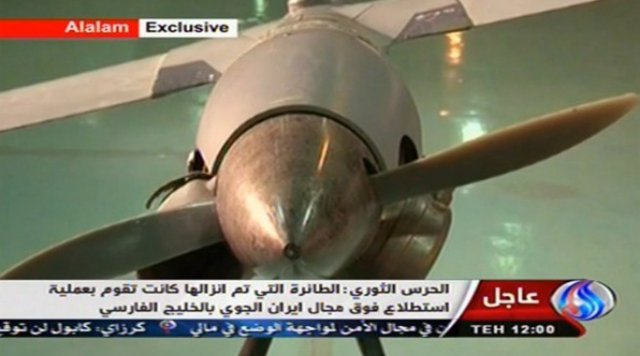 The unmanned aircraft that Iran says it captured appears to be a U.S.-made ScanEagle, Pentagon spokesman George Little said, in a change from the initial U.S. rejection of the Iranian claim.
The unmanned aircraft that Iran says it captured appears to be a U.S.-made ScanEagle, Pentagon spokesman George Little said, in a change from the initial U.S. rejection of the Iranian claim.
While Iran said it extracted valuable data from the unmanned aircraft, Little told reporters yesterday that it was “highly improbable” that useful intelligence could be gained from the relatively unsophisticated drone. He said it couldn’t be determined if it was operated by the U.S.
The ScanEagle, made by Insitu, is used by a number of countries and is less advanced than other unmanned aircraft employed by the Pentagon and the Central Intelligence Agency, such as the Global Hawk and Predator.
Iran said its capture of the aircraft proves the Persian Gulf nation can protect itself from foreign aggression. The drone’s mission was to “gather military data and information pertaining to the energy sector and shipment of crude from Iran’s oil terminals,” Brigadier General Ramezan Sharif, head of the public relations department of Iran’s Revolutionary Guard Corps, said in a report published yesterday in the Tehran-based Etemaad newspaper.
The state-run Press TV news channel showed images yesterday of what it said was a ScanEagle that had been captured intact. The aircraft was seized after violating the Islamic Republic’s airspace, Iranian officials said.
The seizure of the ScanEagle “is not something Americans can easily deny,” Sharif said. The evolving comments from officials in Washington underscored his point.
White House press secretary Jay Carney said Dec. 4 that the U.S. has “no evidence Iranian claims are true.” The U.S. Navy “has fully accounted for all unmanned aerial vehicles operating in the Middle East region,” Commander Jason Salata, a spokesman for the U.S. Fifth Fleet in Bahrain, said the same day.
Yesterday, Little said, “I can’t rule out the possibility that at some point in the past a ScanEagle dropped into the Gulf and was picked up.” He said it couldn’t be determined “whether or not this ScanEagle was a U.S. ScanEagle or somebody else’s.”
A ScanEagle “will offer very limited sensitive technology” to Iran, Philip Finnegan, an aerospace analyst at the Teal Group Corp., a Fairfax, Virginia-based defense-market analysis firm, said Dec. 4 in an e-mailed statement. The system, made by the Insitu unit of Chicago-based Boeing, has been around for almost a decade and is being superseded by a new model called the Integrator, “which will carry considerable more payload,” he said.
“The ScanEagle was never a state-of-the art system,” such as the Global Hawk or Predator drones or the Navy’s Broad Area Maritime Surveillance system, known as BAMS, Finnegan said. It “was originally built for the commercial fishing market and then adapted to military requirements.”
The ScanEagle weighs 40 pounds (18 kilograms) and has a 10- foot (3-meter) wingspan. The system carries cameras and is used “individually or in groups to loiter over trouble spots and provide intelligence, surveillance and reconnaissance data,” according to Boeing’s website. The aircraft can reach altitudes exceeding 16,000 feet and can be launched from U.S. Navy ships.
Ramin Mehmanparast, Iran’s Foreign Ministry spokesman, said yesterday the capture of the drone shows the Islamic Republic’s “defense capability reached a point where we can rely on the talent of the country’s youth to protect our airspace, sea and territory,” according to a report by the state-run Fars news agency.
Source: Bloomberg Business Week
